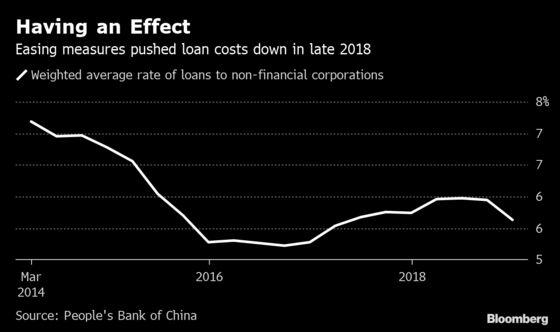Trump Hands Xi Breathing Room on Economy With Deadline Extension
China’s credit and trade both perked up in January, though economists see further slowdown in February manufacturing activity.

(Bloomberg) -- Donald Trump’s decision to extend a deadline on additional tariffs on Chinese goods provides Xi Jinping with some temporary relief as he struggles to arrest an economic slowdown.
Trump announced the extension of the trade truce between the two nations on Sunday, tweeting that if they made further headway in negotiations, he planned to meet Xi at the Mar-a-Lago resort in Florida to end the dispute.
The longer truce may provide China’s economy with a confidence boost just as tentative signs emerge that targeted stimulus measures are helping steady the economy’s deceleration. If China bows to U.S. pressure and further opens up the economy, that could also help make the world’s second-largest economy more productive, further boosting growth.
"China’s policymakers have gained some breathing room," said Eswar Prasad, a former China expert at the International Monetary Fund who is now at Cornell University. "This could prove to be fleeting unless they frontally address overarching concerns about financial risks and lack of reform momentum."

Data for credit and trade both perked up in January, though economists see the first official gauge of February manufacturing activity, scheduled for release Thursday, slowing further. Nevertheless, investors took cheer from the truce news -- U.S. stock futures climbed in Asian trading Monday, Chinese shares surged and the offshore yuan strengthened.
Bottomed Out
China’s economy likely passed its bottom in the fourth quarter last year and strong credit growth in January may be an effective "circuit breaker" to halt the economy’s slide, China International Capital Corp. chief economist Liang Hong wrote in a Feb. 24 note. Economists surveyed by Bloomberg see growth slowing to 6.2 percent in the second quarter and remaining at that pace for the rest of the year.
Any upturn in activity is likely to be won at the cost of more leverage, with evidence mounting that debt is again growing. That’s a change after a nearly two-year anti-debt drive that sank stocks, restrained economic growth, triggered record bond defaults, and pummeled the nation’s shadow-banking industry.
What Our Economists Say... |
| Over the longer term, structural changes such as a strengthened framework on intellectual property rights, which is likely to be part of any trade deal, could also be instrumental in upgrading China’s economic structure. -- Chang Shu and Yuki Masujima, Bloomberg Economics |
The breathing space from an extended truce could reduce the pressure on policy makers to stimulate the economy, a need that’s triggered the turnaround on leverage. Should a broader agreement be reached to roll back existing tariffs, Xi may be able to focus again on his signature deleveraging drive.
A key test for China’s future growth trajectory becomes what happens after the threat of tariffs is removed -- whether Xi keeps any vows to open up to foreign companies, and on implementing measures including financial sector reforms, intellectual property protections and market access.
"This is clearly not the end of the negotiations, let alone the underlying tension between the two countries," said Louis Kuijs, chief Asia economist at Oxford Economics in Hong Kong. "Underlying tensions on technology, China’s industrial policy and, more broadly, its rise, will not subside any time soon."
To contact Bloomberg News staff for this story: Kevin Hamlin in Beijing at khamlin@bloomberg.net
To contact the editors responsible for this story: Jeffrey Black at jblack25@bloomberg.net, James Mayger
©2019 Bloomberg L.P.
With assistance from Bloomberg